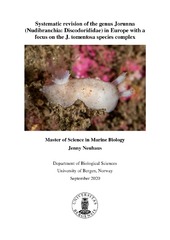Systematic revision of the genus Jorunna (Nudibranchia: Discodorididae) in Europe with a focus on the J. tomentosa species complex
Master thesis
Permanent lenke
https://hdl.handle.net/1956/24462Utgivelsesdato
2020-09-01Metadata
Vis full innførselSamlinger
- Master theses [257]
Sammendrag
Jorunna is a genus of Nudibranchia in the family Discodorididae, currently comprising 21 recognized valid species with a worldwide coastal distribution in the four main biogeographical regions Eastern and Western Atlantic, Eastern Pacific and the Indo-West Pacific. This study presents a systematic revision of the currently valid European species J. tomentosa, J. efe, J. evansi, J. onubensis, and J. spazzola in addition to a generic assessment of Gargamella lemchei, former Jorunna lemchei. The taxonomic status of J. tomentosa sensu lato was revised using an integrative approach combining morpho-anatomical studies with molecular phylogenetics. Two mitochondrial genes, cytochrome c oxidase subunit I (COI) and 16S ribosomal RNA (16S), as well as the nuclear gene histone 3 (H3), were amplified and sequenced (n = 114 novel sequences). The phylogenetic relationships were inferred using Bayesian and maximum likelihood analyses. The molecular species delimitation method Automatic Barcode Gap Discovery was used to aid delimiting species. Genetic uncorrected p-distances based on the gene COI were estimated between and within species. Animals were dissected for the reproductive system, radulae, and labial cuticles using a stereo microscope. Scanning electron microscopy was employed to study ultrastructural elements of anatomical characters. The results revealed the first record of cryptic speciation in Jorunna, disclosing the pseudo-cryptic species Jorunna sp. nov. and a possible case of incipient speciation in J. tomentosa, with the genes COI and 16S supporting the occurrence of two lineages, namely J. tomentosa A and J. tomentosa B (interspecific COI uncorrected p-distance = 3.2–5.0%). Jorunna sp. nov. was found to be 9.0–12.3% genetically distinct from its sister species J. tomentosa and is characterized by a white to yellow background colour with irregularly placed small brown spots, smooth radular teeth and a copulatory spine up to 600 μm longer compared to J. tomentosa. No distinct morphological differences could be found between J. tomentosa lineage A and B. The generic assignment of J. lemchei to the genus Gargamella is questioned because of the presence of a copulatory spine, a feature absent in all other species of this genus.
